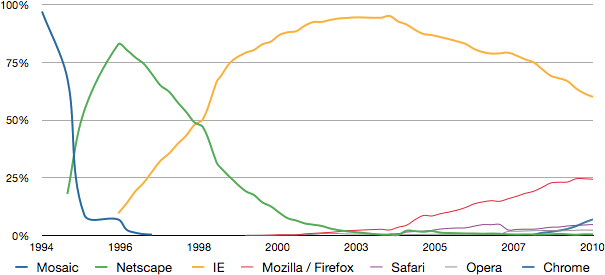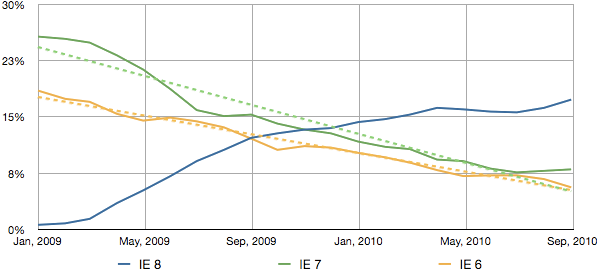Browser usage statistics - past, present and future
Every web developer knows this story... Microsoft arrived late to the Internet party, but they huffed and they puffed... and they bundled their browser in with their dominating OS... and they blew down the house which Netscape built. After this, they congratulated themselves for winning the Browser wars and proceeded to sit on their laurels for over half a decade.
Over the years using Internet Explorer became synonymous with using the Internet for most "regular" users. This created huge headaches for web developers, who had to support the stale platform, while much more powerful and feature rich browsers lay dormant and undiscovered. It turned out that the afore mentioned regular users didn't really know what a browser was, why they should change it or even update it.
Black hat hackers, scammers and spammers had a field day with this, exploiting literally hundreds of security vulnerabilities in unpatched versions of IE. It took many years, but finally even regular users are beginning to understand, that there might be a reason not to use IE 6.
Past
There are two charts, I would like to share with you. The first one is just an illustration, which demonstrates two things. Firstly point is the enormous influence of Microsoft on the world over the last decade and a half. And the second is the lack of savvy of users, who once presented with a browser are content to use it without question.

This chart shows the history of the Internet broken down by browser usage. It illustrates, how the early internet was once dominated by the first popular graphical browser Mosaic, the rise and fall of Netscape Navigator, and finally the rise and steady decline of Internet Explorer. The bottom right corner of the chart is where all the action is today, with Firefox, Chrome, Safari and the eternal Opera each vying for users' attention.
Future
The biggest causes of headache for web developers are the oldest versions of Internet Explorer, which are still inexplicably popular, namely IE 6 and 7. Let's be honest, by today's standards, these browsers suck. They have limited support for CSS, very inefficient JavaScript engines, need I go on? The poor web developer may make an excellent site in HTML5/CSS3 which will work in all browsers, but it will of course not work in IE. Are we stuck with this situation forever?

Hopefully no. This second chart illustrates the trends among users of IE over the past 2 years. As this chart shows, users are finally switching over to IE 8. If this trend continues (dashed lines in the chart are trend lines) older versions of IE should become marginalized by the end of 2011. Just one more year people, and we'll be free!